[English] 日本語
 Yorodumi
Yorodumi- PDB-7dz7: State transition supercomplex PSI-LHCI-LHCII from double phosphat... -
+ Open data
Open data
- Basic information
Basic information
| Entry | Database: PDB / ID: 7dz7 | ||||||||||||||||||||||||||||||||||||
|---|---|---|---|---|---|---|---|---|---|---|---|---|---|---|---|---|---|---|---|---|---|---|---|---|---|---|---|---|---|---|---|---|---|---|---|---|---|
| Title | State transition supercomplex PSI-LHCI-LHCII from double phosphatase mutant pph1;pbcp of green alga Chlamydomonas reinhardtii | ||||||||||||||||||||||||||||||||||||
 Components Components |
| ||||||||||||||||||||||||||||||||||||
 Keywords Keywords | PHOTOSYNTHESIS / Supercomplex / state transition / green alga / Chlamydomonas reinhardtii | ||||||||||||||||||||||||||||||||||||
| Function / homology |  Function and homology information Function and homology informationphotosynthesis, light harvesting in photosystem I / photosynthesis, light harvesting / chloroplast thylakoid lumen / photosystem I reaction center / photosystem I / photosynthetic electron transport in photosystem I / photosystem I / photosystem II / chlorophyll binding / chloroplast thylakoid membrane ...photosynthesis, light harvesting in photosystem I / photosynthesis, light harvesting / chloroplast thylakoid lumen / photosystem I reaction center / photosystem I / photosynthetic electron transport in photosystem I / photosystem I / photosystem II / chlorophyll binding / chloroplast thylakoid membrane / response to light stimulus / photosynthesis / 4 iron, 4 sulfur cluster binding / oxidoreductase activity / electron transfer activity / magnesium ion binding / metal ion binding Similarity search - Function | ||||||||||||||||||||||||||||||||||||
| Biological species |  | ||||||||||||||||||||||||||||||||||||
| Method | ELECTRON MICROSCOPY / single particle reconstruction / cryo EM / Resolution: 2.84 Å | ||||||||||||||||||||||||||||||||||||
 Authors Authors | Pan, X.W. / Li, A.J. / Liu, Z.F. / Li, M. | ||||||||||||||||||||||||||||||||||||
| Funding support |  China, China,  Japan, 8items Japan, 8items
| ||||||||||||||||||||||||||||||||||||
 Citation Citation |  Journal: Nat Plants / Year: 2021 Journal: Nat Plants / Year: 2021Title: Structural basis of LhcbM5-mediated state transitions in green algae. Authors: Xiaowei Pan / Ryutaro Tokutsu / Anjie Li / Kenji Takizawa / Chihong Song / Kazuyoshi Murata / Tomohito Yamasaki / Zhenfeng Liu / Jun Minagawa / Mei Li /   Abstract: In green algae and plants, state transitions serve as a short-term light-acclimation process in the regulation of the light-harvesting capacity of photosystems I and II (PSI and PSII, respectively). ...In green algae and plants, state transitions serve as a short-term light-acclimation process in the regulation of the light-harvesting capacity of photosystems I and II (PSI and PSII, respectively). During the process, a portion of light-harvesting complex II (LHCII) is phosphorylated, dissociated from PSII and binds with PSI to form the supercomplex PSI-LHCI-LHCII. Here, we report high-resolution structures of PSI-LHCI-LHCII from Chlamydomonas reinhardtii, revealing the mechanism of assembly between the PSI-LHCI complex and two phosphorylated LHCII trimers containing all four types of LhcbM protein. Two specific LhcbM isoforms, namely LhcbM1 and LhcbM5, directly interact with the PSI core through their phosphorylated amino terminal regions. Furthermore, biochemical and functional studies on mutant strains lacking either LhcbM1 or LhcbM5 indicate that only LhcbM5 is indispensable in supercomplex formation. The results unravel the specific interactions and potential excitation energy transfer routes between green algal PSI and two phosphorylated LHCIIs. | ||||||||||||||||||||||||||||||||||||
| History |
|
- Structure visualization
Structure visualization
| Movie |
 Movie viewer Movie viewer |
|---|---|
| Structure viewer | Molecule:  Molmil Molmil Jmol/JSmol Jmol/JSmol |
- Downloads & links
Downloads & links
- Download
Download
| PDBx/mmCIF format |  7dz7.cif.gz 7dz7.cif.gz | 1.5 MB | Display |  PDBx/mmCIF format PDBx/mmCIF format |
|---|---|---|---|---|
| PDB format |  pdb7dz7.ent.gz pdb7dz7.ent.gz | 1.3 MB | Display |  PDB format PDB format |
| PDBx/mmJSON format |  7dz7.json.gz 7dz7.json.gz | Tree view |  PDBx/mmJSON format PDBx/mmJSON format | |
| Others |  Other downloads Other downloads |
-Validation report
| Summary document |  7dz7_validation.pdf.gz 7dz7_validation.pdf.gz | 23.8 MB | Display |  wwPDB validaton report wwPDB validaton report |
|---|---|---|---|---|
| Full document |  7dz7_full_validation.pdf.gz 7dz7_full_validation.pdf.gz | 24.8 MB | Display | |
| Data in XML |  7dz7_validation.xml.gz 7dz7_validation.xml.gz | 342.5 KB | Display | |
| Data in CIF |  7dz7_validation.cif.gz 7dz7_validation.cif.gz | 408.2 KB | Display | |
| Arichive directory |  https://data.pdbj.org/pub/pdb/validation_reports/dz/7dz7 https://data.pdbj.org/pub/pdb/validation_reports/dz/7dz7 ftp://data.pdbj.org/pub/pdb/validation_reports/dz/7dz7 ftp://data.pdbj.org/pub/pdb/validation_reports/dz/7dz7 | HTTPS FTP |
-Related structure data
| Related structure data |  30925MC  7dz8C  7e0hC  7e0iC  7e0jC  7e0kC M: map data used to model this data C: citing same article ( |
|---|---|
| Similar structure data |
- Links
Links
- Assembly
Assembly
| Deposited unit | 
|
|---|---|
| 1 |
|
- Components
Components
-Photosystem I ... , 12 types, 12 molecules ABCDEFGHIJKO
| #1: Protein | Mass: 83239.203 Da / Num. of mol.: 1 / Source method: isolated from a natural source / Source: (natural)  |
|---|---|
| #2: Protein | Mass: 82184.266 Da / Num. of mol.: 1 / Source method: isolated from a natural source / Source: (natural)  |
| #3: Protein | Mass: 8869.325 Da / Num. of mol.: 1 / Source method: isolated from a natural source / Source: (natural)  |
| #4: Protein | Mass: 21372.887 Da / Num. of mol.: 1 / Source method: isolated from a natural source / Source: (natural)  |
| #5: Protein | Mass: 10786.395 Da / Num. of mol.: 1 / Source method: isolated from a natural source / Source: (natural)  |
| #6: Protein | Mass: 24088.936 Da / Num. of mol.: 1 / Source method: isolated from a natural source / Source: (natural)  |
| #7: Protein | Mass: 13236.007 Da / Num. of mol.: 1 / Source method: isolated from a natural source / Source: (natural)  |
| #8: Protein | Mass: 14173.131 Da / Num. of mol.: 1 / Source method: isolated from a natural source / Source: (natural)  |
| #9: Protein | Mass: 10586.388 Da / Num. of mol.: 1 / Source method: isolated from a natural source / Source: (natural)  |
| #10: Protein/peptide | Mass: 4750.509 Da / Num. of mol.: 1 / Source method: isolated from a natural source / Source: (natural)  |
| #11: Protein | Mass: 11214.084 Da / Num. of mol.: 1 / Source method: isolated from a natural source / Source: (natural)  |
| #13: Protein | Mass: 13753.862 Da / Num. of mol.: 1 / Source method: isolated from a natural source / Source: (natural)  |
-Protein , 1 types, 1 molecules L
| #12: Protein | Mass: 20300.539 Da / Num. of mol.: 1 / Source method: isolated from a natural source / Source: (natural)  |
|---|
-Chlorophyll a-b binding protein, ... , 13 types, 16 molecules a123456789XWYUZV
| #14: Protein | Mass: 23923.205 Da / Num. of mol.: 2 / Source method: isolated from a natural source / Source: (natural)  #15: Protein | | Mass: 26951.219 Da / Num. of mol.: 1 / Source method: isolated from a natural source / Source: (natural)  #16: Protein | | Mass: 32629.486 Da / Num. of mol.: 1 / Source method: isolated from a natural source / Source: (natural)  #17: Protein | | Mass: 28729.822 Da / Num. of mol.: 1 / Source method: isolated from a natural source / Source: (natural)  #18: Protein | | Mass: 28257.555 Da / Num. of mol.: 1 / Source method: isolated from a natural source / Source: (natural)  #19: Protein | | Mass: 27812.373 Da / Num. of mol.: 1 / Source method: isolated from a natural source / Source: (natural)  #20: Protein | | Mass: 26248.869 Da / Num. of mol.: 1 / Source method: isolated from a natural source / Source: (natural)  #21: Protein | | Mass: 25948.812 Da / Num. of mol.: 1 / Source method: isolated from a natural source / Source: (natural)  #22: Protein | | Mass: 22867.277 Da / Num. of mol.: 1 / Source method: isolated from a natural source / Source: (natural)  #23: Protein | Mass: 26675.350 Da / Num. of mol.: 2 / Source method: isolated from a natural source / Source: (natural)  #24: Protein | Mass: 27405.008 Da / Num. of mol.: 2 / Source method: isolated from a natural source / Source: (natural)  #25: Protein | | Mass: 27671.316 Da / Num. of mol.: 1 / Source method: isolated from a natural source / Source: (natural)  #26: Protein | | Mass: 28796.824 Da / Num. of mol.: 1 / Source method: isolated from a natural source / Source: (natural)  |
|---|
-Sugars , 2 types, 8 molecules 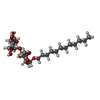


| #32: Sugar | ChemComp-LMU / #34: Sugar | ChemComp-DGD / | |
|---|
-Non-polymers , 10 types, 463 molecules 
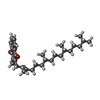




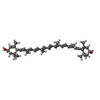
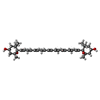
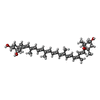
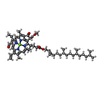









| #27: Chemical | ChemComp-CLA / #28: Chemical | #29: Chemical | ChemComp-LHG / #30: Chemical | ChemComp-BCR / #31: Chemical | #33: Chemical | ChemComp-LMG / #35: Chemical | ChemComp-LUT / ( #36: Chemical | ChemComp-XAT / ( #37: Chemical | ChemComp-NEX / ( #38: Chemical | ChemComp-CHL / |
|---|
-Details
| Has ligand of interest | Y |
|---|---|
| Has protein modification | Y |
-Experimental details
-Experiment
| Experiment | Method: ELECTRON MICROSCOPY |
|---|---|
| EM experiment | Aggregation state: PARTICLE / 3D reconstruction method: single particle reconstruction |
- Sample preparation
Sample preparation
| Component | Name: State transition complex PSI-LHCI-LHCII from green algae Type: COMPLEX / Entity ID: #1-#26 / Source: NATURAL |
|---|---|
| Molecular weight | Experimental value: YES |
| Source (natural) | Organism:  |
| Buffer solution | pH: 6.5 |
| Specimen | Embedding applied: NO / Shadowing applied: NO / Staining applied: NO / Vitrification applied: YES |
| Vitrification | Cryogen name: ETHANE |
- Electron microscopy imaging
Electron microscopy imaging
| Experimental equipment |  Model: Talos Arctica / Image courtesy: FEI Company |
|---|---|
| Microscopy | Model: FEI TALOS ARCTICA |
| Electron gun | Electron source:  FIELD EMISSION GUN / Accelerating voltage: 200 kV / Illumination mode: FLOOD BEAM FIELD EMISSION GUN / Accelerating voltage: 200 kV / Illumination mode: FLOOD BEAM |
| Electron lens | Mode: BRIGHT FIELD |
| Image recording | Electron dose: 1.5625 e/Å2 / Film or detector model: GATAN K2 SUMMIT (4k x 4k) |
- Processing
Processing
| Software | Name: PHENIX / Version: 1.17.1_3660: / Classification: refinement | ||||||||||||||||||||||||
|---|---|---|---|---|---|---|---|---|---|---|---|---|---|---|---|---|---|---|---|---|---|---|---|---|---|
| EM software | Name: PHENIX / Category: model refinement | ||||||||||||||||||||||||
| CTF correction | Type: PHASE FLIPPING AND AMPLITUDE CORRECTION | ||||||||||||||||||||||||
| 3D reconstruction | Resolution: 2.84 Å / Resolution method: FSC 0.143 CUT-OFF / Num. of particles: 56601 / Symmetry type: POINT | ||||||||||||||||||||||||
| Refine LS restraints |
|
 Movie
Movie Controller
Controller







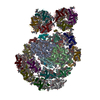
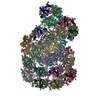


 PDBj
PDBj





















